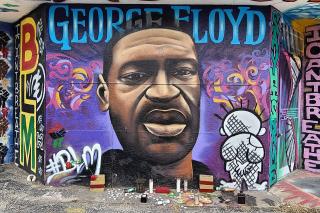School of Library and Information Science Assistant Professor Ann Graf published an article, “Domain Analysis Applied to Online Graffiti Art Image Galleries to Reveal Knowledge Organization Structures Used Within an Outsider Art Community," in Knowledge Organization 47 no. 7. We talked with her about exploring this art form.

“I was raised by parents into art and photography,” says Assistant Professor Ann Graf. Having moved several times in the past three years, she took frequent walks to get to know each new community and often came across graffiti. “I was pleasantly surprised by some of the stuff out there and took pictures whenever I found it.”
When Graf took a digital libraries course for her master’s degree, she chose to create a digital collection of graffiti art, and her passion for the art form only grew from there. “I realized that this is an outsider community not well represented in controlled vocabularies. Also, it brings together my love for art, typography, photography, documentation, and cataloging — it ties it all together.”
When she pursued her PhD at the University of Wisconsin-Milwaukee, her thesis chair wanted her to research the data from an extensive bibliography she had created on the history of Milwaukee. “I really wanted to look at graffiti art around the world and explore how it is documented. He didn’t really understand.” Steadfast, Graf forged ahead with the thesis, interviewing people from around the world.
“A PhD is a lot of work,” says Graf, “if I’m going to suffer doing this work, it needs to have meaning. You need to do something that sparks interest in you. That passion is going to carry you through the hard parts of the research.”
While formal art institutions are not cataloging graffiti and street art, it is being cataloged all over the world. She looked at over 200 websites for her dissertation, all of them describing art in different areas. “There is a community of artists, people who document the art, and people who share a common love for the art form. They share a common vocabulary for how they describe it.”
I really wanted to look at graffiti art around the world and explore how it is documented.
Before completing her dissertation, Graf wrote a paper about the terminology used to classify these works. Since then, the Art & Architecture Thesaurus (AAT) has adopted 80% of the terms she reported, citing many of the same sources. While she doubts the catalogers of graffiti art take note of this change, Graf thinks it is significant. “The AAT should include the terminology that the community is using, instead of an academic using terms for them. Their voice is represented for the rest of the world who may want to talk about these works of art.”
Part of the appeal of graffiti is its ephemeral — and impermanent — nature. “I love the immediate artistic response I’ve seen to social crises.” Graf started seeing graffiti related to the COVID-19 pandemic in April of 2020. “There was artwork related to the virus — images of masks, toilet paper, and Lysol. There were a lot of wishes for people to stay safe, stay six feet apart. A lot of messages of thanks to health care workers, and images of doctors and nurses were common.”
Graf has been tracking visual themes that show up on social media, especially Instagram, grabbing screenshots of anything with taglines or hashtag “COVID graffiti.” Now she’s analyzing these findings for a paper on the subject.
2020 was also marked by social unrest in the wake of police brutality, which inspired a swift and resounding response from graffiti artists and street artists. “There was a strong response in the streets. A lot of the works are memorials to those who have been killed.” Capturing and tracking these images is vital, as they can be painted over at any time.
“Having a date on the work is important — the date when the photo was taken, not just when it was posted to Instagram,” explains Graf. “There are creative documentation strategies for tracking things like this — urban art mapping projects that record the location of specific graffiti. Sometimes it could be added to or messed with, or removed. It’s out there in the wild, and it’s going to degrade from the weather and the elements. This is why the photos are so important.”
For those interested in learning more about graffiti, Graf says Instagram is a great place to search using the hashtags #graffiti, #graffitiart, #murals, and #streetart. But she’s an even bigger proponent of urban exploration. “I haven’t had a car since 2012. I walk everywhere, I see the world differently, and I record it — I’m a documentationalist at heart. I’m always taking photos, looking down alleys, not taking the same route every day. You’ll be amazed at what you’ll find.”

